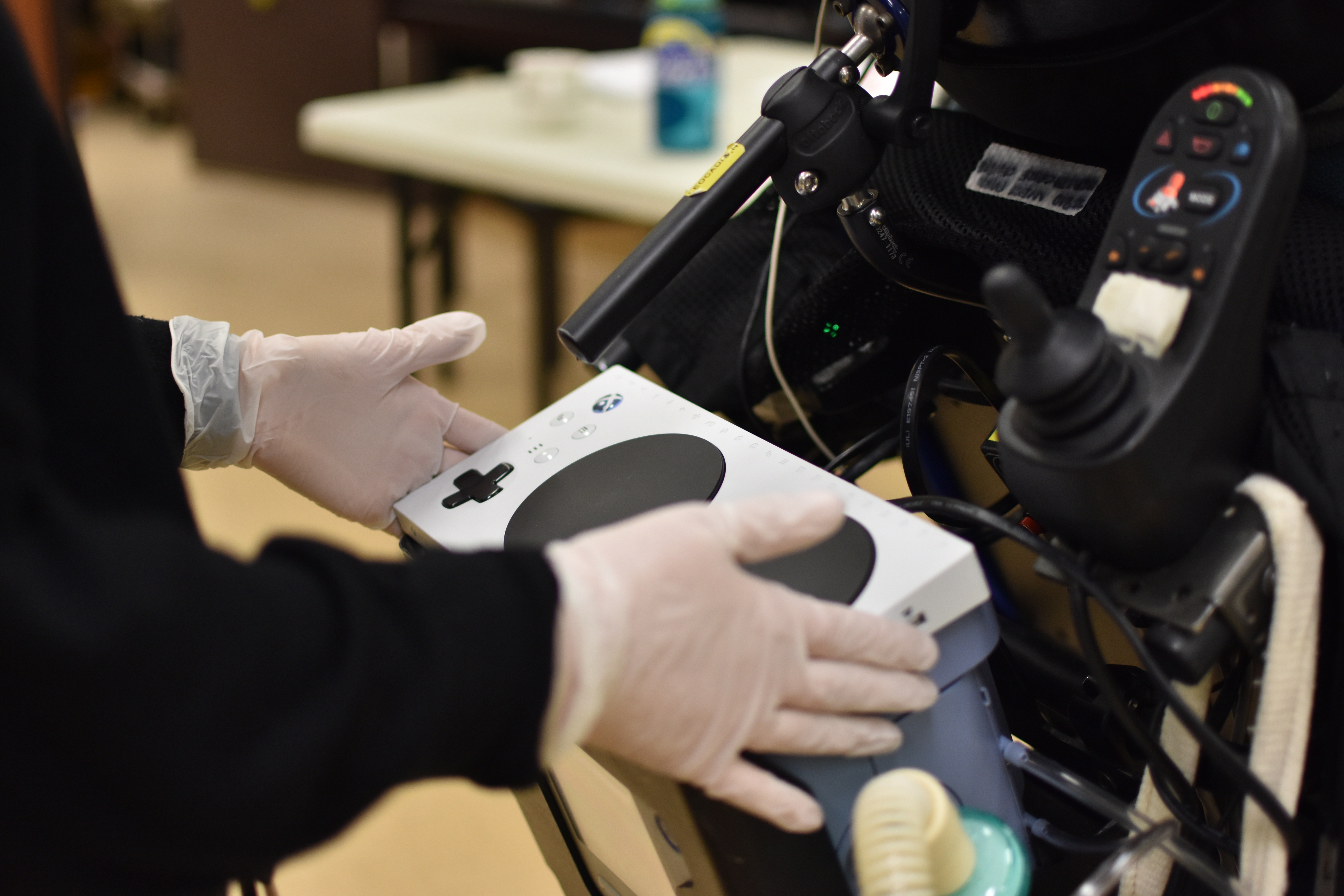Pictured above: Gamer and West Park Healthcare Centre patient Nic Leocadio uses his chin
and mouth to operate the controller as he participates in the Centre’s adaptive
gaming program. Prior to joining the program, Leocadio says he hadn’t played
video games in 14 years. (Credit: Michelle Rowe-Jardine/West Park Healthcare
Centre)
By: Michelle Rowe-Jardine, Communications Coordinator, West Park Healthcare Centre
Marc Barclay lets out a cheer as he sinks another three-pointer in NBA 2K19 for Xbox. The 30-year-old was an emphatic gamer growing up, playing everything from Need for Speed to FIFA.
“I went really hard with video games in high school," he says.
But now, his mobility can't conform to the rigid constraints of a standard gaming controller.
Barclay is a Complex Continuing Care patient at West Park Healthcare Centre who has recently been able to rekindle a relationship with video games through the Centre's adaptive-gaming program.
The Xbox Program, which has been fully operating for about two years, aims to bring gaming to wider audiences by incorporating adaptive controllers that can be tailored to the players.
With the support of the Scotiabank Youth Transition Program, the Centre was able to purchase over $10,000 in technologies and equipment to support the initiative.
Occupational Therapist Timothy Park, who started the program, says video games are typically restricted to able-bodied persons, but with the Xbox program, patients gain the ability to play some of the same popular games as their peers.
“I was interested in developing this program because a lot of games that are designed for people with disabilities are just that, they're designed specifically for people with disabilities, or they're designed for rehab purposes. They're not designed, necessarily, for pure enjoyment."
Because of this, he says, many patients may lose interest in gaming.
“Video games are very much a social activity too. If there's no relatability, there's no social interaction."
How does it work?

The program uses the Xbox Adaptive Controller by Microsoft, which is highly customizable in its ability to employ various specialty switches and joysticks to meet the unique needs of the player. It also involves a collaboration between West Park's occupational therapists and the recreation therapy team to then try and customize the controller to fit each patient's abilities.
Pictured right: The Xbox adaptive controller comes with multiple jacks and ports where various external buttons and joysticks can be connected to meet the unique needs of each player. (Michelle Rowe-Jardine/West Park Healthcare Centre)
Occupational therapists or OT students work with patients to get them set up on the Xbox adaptive controller. Assessments are done, often over many sessions, to determine where a patient's strongest points on their body are, called access points. Sometimes it just involves adding one extra button, or remapping where the buttons are. Other participants may require a more complex setup with multiple switches to employ the use of their mouths, head, etc.
Once those assessments are complete, a guide is created for each patient that explains their unique set-ups. The guide is complete with pictures showing where the switches go and how they're used, including how much force is needed to press the button, what switches activate which buttons, and what games the individual likes to play.
And it's about constant refinement, Park says. The set-up may work fine one day, but next time the patient might want to tweak it slightly to improve gameplay, or they're ready to add another switch and make it a bit more complex, he says.
“That's part of the good thing about the program. It kind of pushes them to keep expanding their horizons. It pushes them to want to excel and find more ways to do things."
Barclay started with the adaptive controller, but he has since been able to utilize a standard controller by working with staff on reassigning certain buttons and using an object to stabilize the controller in his hands.
Chronic Assisted Ventilatory Care patient Jevan Wright has been in the program for about a year. He began using three switches, or access points, pretty quickly after joining but has since moved up to six points on the body that can help move the controller.
Wright has been a gamer his whole life, and when he got to West Park, he saw an opportunity to re-engage with one of his favourite pastimes. Having been a PlayStation user, Wright says he's been won over by Xbox and its adaptive controller because “they get everyone involved, and because of that, the gaming community here has been expanding."
Wright created a TikTok account to showcase his gaming and one of his videos has about 100,000 views.
“Patients aren't really going anywhere … so patients are going to get bored and it's great to offer something new, and something out there in the world," he says.
Connecting patients to 'a whole different world'
Recreation Therapy Assistant Erin Delaney had been working on the program since she started at West Park over a year ago, and she says it provides something different for the patient experience.
“We offer a lot of interactive programming in person. But this connects patients to a whole different world, a whole virtual world, where they can participate in something that's tailored not just for someone with a disability.
“And they could play online if they wanted to … and be able to play with anyone around the world, connecting them outside of just the hospital and their immediate space. So I think it gives them a big opportunity for engagement."
She says some patients have been creating social-media accounts because they're proud of their progress and want to showcase it online.
“It's therapeutic in the way that it is engaging and provides socialization, but it doesn't need to be therapy for a goal. It's therapy as enjoyment. And from that comes self-actualization and having goals."